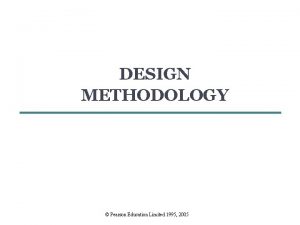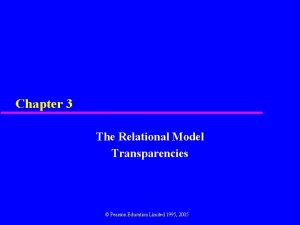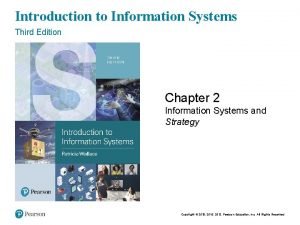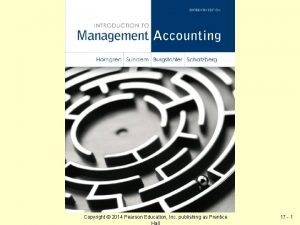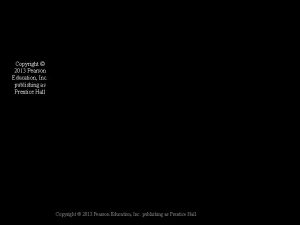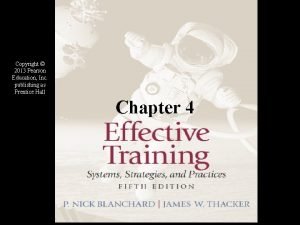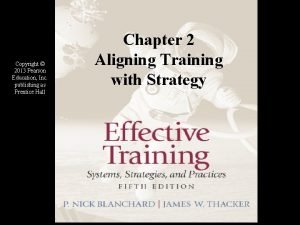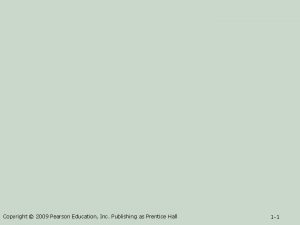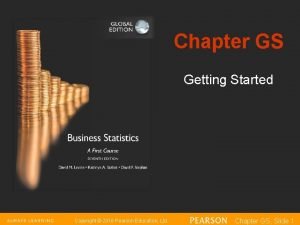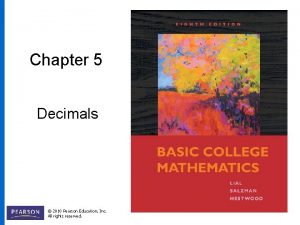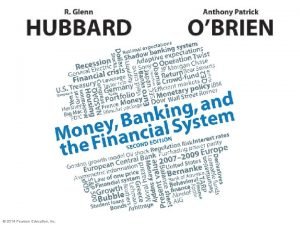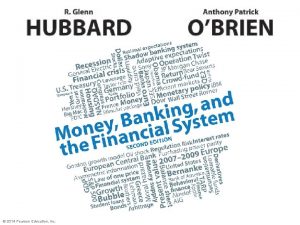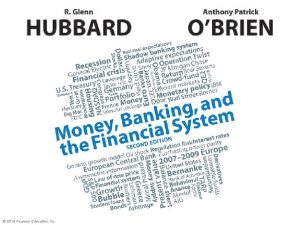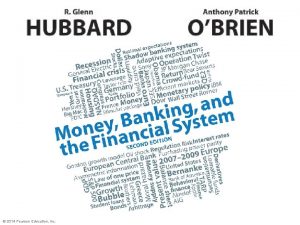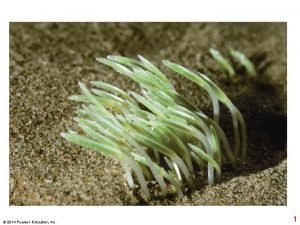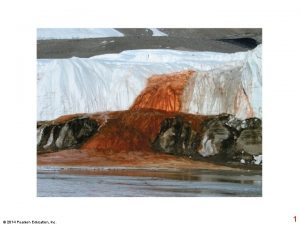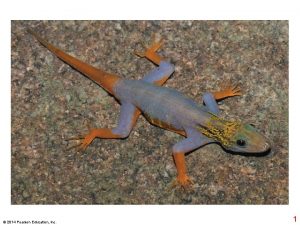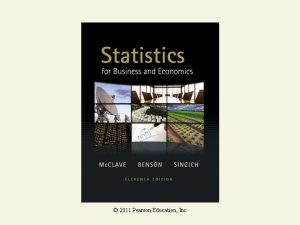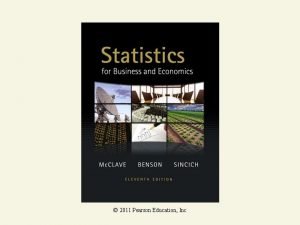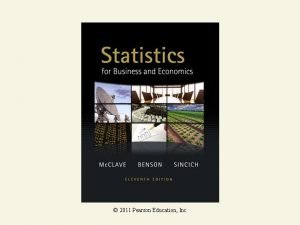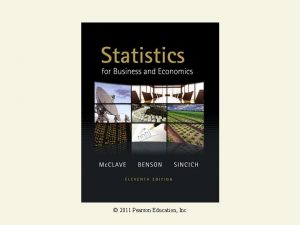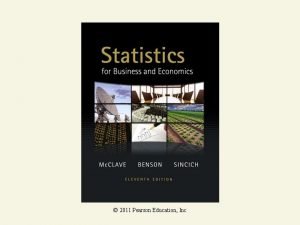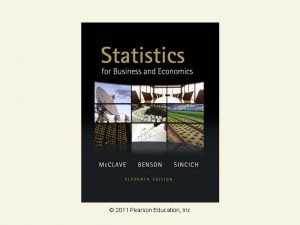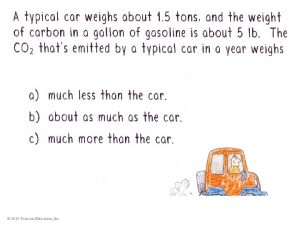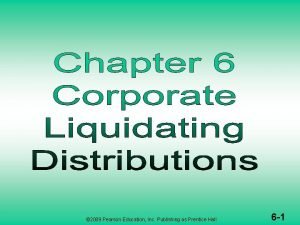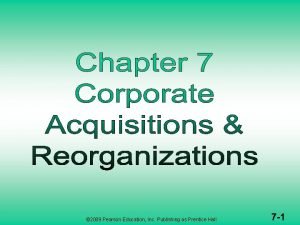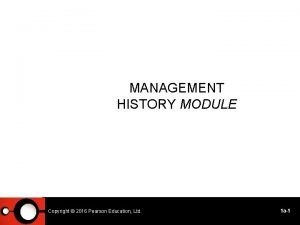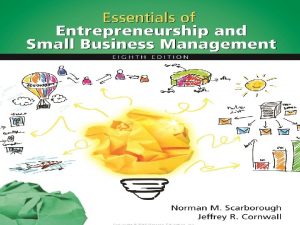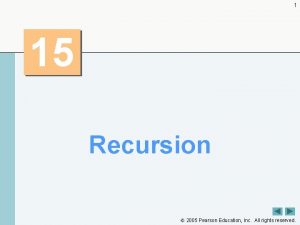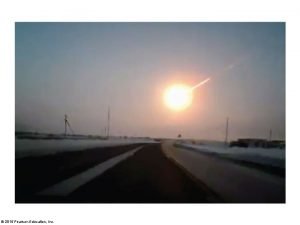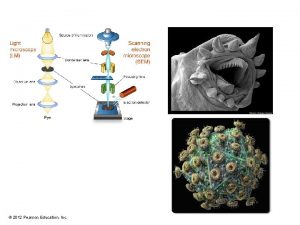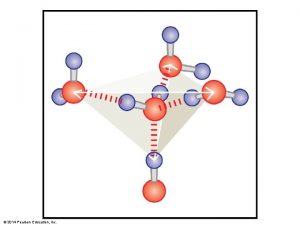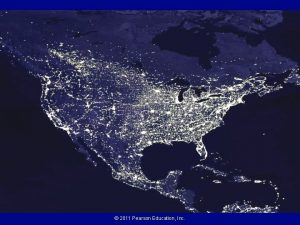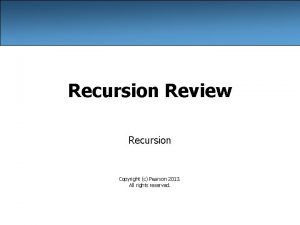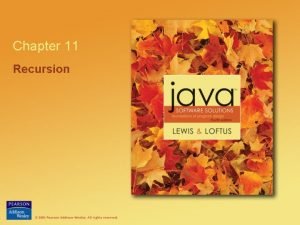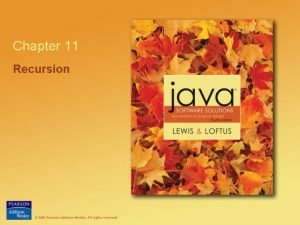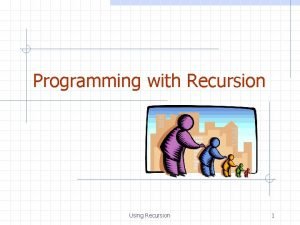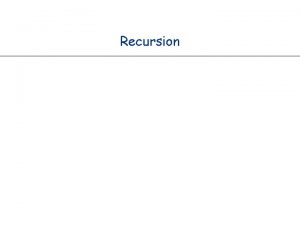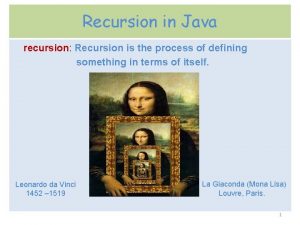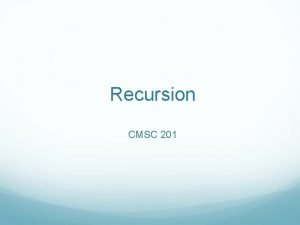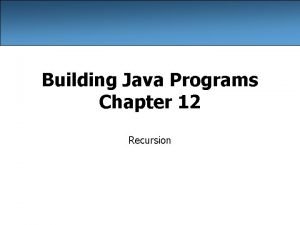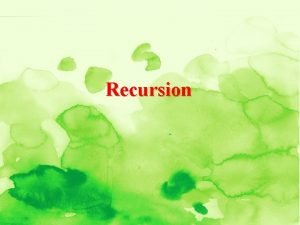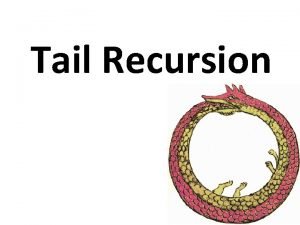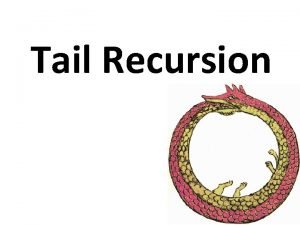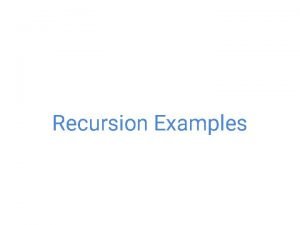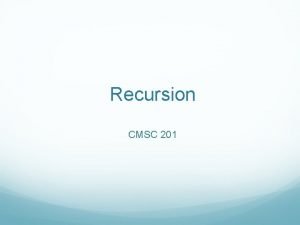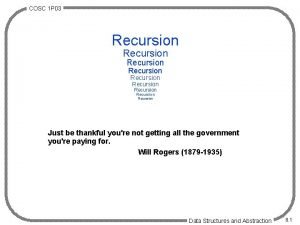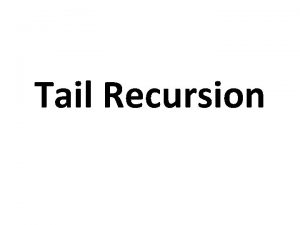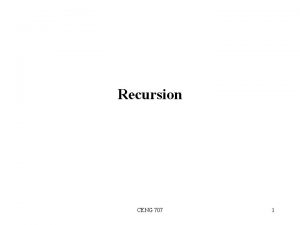1 15 Recursion 2005 Pearson Education Inc All

























































- Slides: 57

1 15 Recursion 2005 Pearson Education, Inc. All rights reserved.

2 It's a poor sort of memory that only works backwards. —Lewis Carroll, Alice in Wonderland We must learn to explore all the options and possibilities that confront us in a complex and rapidly changing world. —James William Fulbright Push on—keep moving. —Thomas Morton O! thou hast damnable iteration, and art indeed able to corrupt a saint. —William Shakespeare Life can only be understood backwards; but it must be lived forwards. —Soren Kierkegaard 2005 Pearson Education, Inc. All rights reserved.

3 OBJECTIVES In this chapter you will learn: § The concept of recursion. § How to write and use recursive methods. § How to determine the base case and recursion step in a recursive algorithm. § How recursive method calls are handled by the system. § The differences between recursion and iteration, and when it is appropriate to use each. 2005 Pearson Education, Inc. All rights reserved.

4 15. 1 Introduction 15. 2 Recursion Concepts 15. 3 Example Using Recursion: Factorials 15. 4 Example Using Recursion: Fibonacci Series 15. 5 Recursion and the Method Call Stack 15. 6 Recursion vs. Iteration 15. 7 String Permutations 15. 8 Towers of Hanoi 15. 9 Fractals 15. 10 Recursive Backtracking 15. 11 Wrap-Up 15. 12 Internet and Web Resources 2005 Pearson Education, Inc. All rights reserved.

5 15. 1 Introduction • Earlier programs structured as methods that call one another in a disciplined, hierarchical manner • Recursive methods – Call themselves – Useful for some problems to define a method to call itself – Can be called directly or indirectly through another method 2005 Pearson Education, Inc. All rights reserved.

6 Fig. 15. 1 | Summary of the 32 recursion examples and exercises in this text. (Part 1 of 2) 2005 Pearson Education, Inc. All rights reserved.

7 Fig. 15. 1 | Summary of the 32 recursion examples and exercises in this text. (Part 2 of 2) 2005 Pearson Education, Inc. All rights reserved.

8 15. 2 Recursion Concepts • Recursive problem-solving elements – Base case • Recursive method capable of solving only simplest case—the base case • If method is called with base case, method returns result – If method is called with more complex problem, problem divided into two pieces—a piece the method knows how to do and a piece the method does not know how to do (called recursive call or recursion step) – Recursive call/recursion step • Must resemble original problem but be slightly simpler or smaller version • Method calls fresh copy of itself to work on smaller problem • Normally includes return statement • Indirect recursion – Recursive method calls another method that eventually makes call back to recursive method 2005 Pearson Education, Inc. All rights reserved.

15. 3 Example Using Recursion: Factorials 9 • Factorial of n, or n! is the product n · (n – 1) · (n – 2) · … · 1 With 1! equal to 1 and 0! Defined to be 1. • Can be solved recursively or iteratively (nonrecursively) • Recursive solution uses following relationship: n! = n · (n – 1)! • Infinite recursion – recursive calls are continuously made until memory has been exhausted – Caused by either omitting base case or writing recursion step that does not converge on base case 2005 Pearson Education, Inc. All rights reserved.

10 Fig. 15. 2 | Recursive evaluation of 5!. 2005 Pearson Education, Inc. All rights reserved.

Outline 11 Factorial Base case returns 1 Calculator. java Recursion step breaks problem into two parts: one the method knows how to do, one the method does not Portion method. Recursive knows how call: to Portion do method does not know how to do; smaller version of original problem Original call to recursive method 2005 Pearson Education, Inc. All rights reserved.

12 Common Programming Error 15. 1 Either omitting the base case or writing the recursion step incorrectly so that it does not converge on the base can cause a logic error known as infinite recursion, where recursive calls are continuously made until memory has been exhausted. This error is analogous to the problem of an infinite loop in an iterative (nonrecursive) solution. 2005 Pearson Education, Inc. All rights reserved.

Outline 13 Factorial. Test. java Calculate and display factorials 2005 Pearson Education, Inc. All rights reserved.

15. 4 Example Using Recursion: Fibonacci Series 14 • Fibonacci series begins with 0 and 1 and has property that each subsequent Fibonacci number is the sum of previous two Fibonacci numbers. • Series occurs in nature, ratio of successive Fibonacci numbers converges on golden ratio or golden mean • Fibonacci series defined recursively as: fibonacci(0) = 0 fibonacci(1) = 1 fibonacci(n) = fibonacci(n – 1) + fibonacci(n – 2) • Recursive solution for calculating Fibonacci values results in explosion of recursive method calls 2005 Pearson Education, Inc. All rights reserved.

Outline Two base cases 15 Fibonacci Calculator. java Two recursive calls Original call to recursive method 2005 Pearson Education, Inc. All rights reserved.

Outline 16 Fibonacci. Test. java Calculate and display Fibonacci values 2005 Pearson Education, Inc. All rights reserved.

17 Fig. 15. 7 | Set of recursive calls for fibonacci( 3 ). 2005 Pearson Education, Inc. All rights reserved.

18 Performance Tip 15. 1 Avoid Fibonacci-style recursive programs, because they result in an exponential “explosion” of method calls. 2005 Pearson Education, Inc. All rights reserved.

19 15. 5 Recursion and the Method Call Stack • Method call stack used to keep track of method calls and local variables within a method call • Just as with nonrecursive programming, recursive method calls are placed at the top of the method call stack • As recursive method calls return, their activation records are popped off the stack and the previous recursive calls continue executing • Current method executing is always method whose activation record is at top of stack 2005 Pearson Education, Inc. All rights reserved.

20 Fig. 15. 8 | Method calls made within the call fibonacci( 3 ). 2005 Pearson Education, Inc. All rights reserved.

21 Fig. 15. 9 | Method calls on the program execution stack. 2005 Pearson Education, Inc. All rights reserved.

22 15. 6 Recursion vs. Iteration • Any problem that can be solved recursively can be solved iteratively • Both iteration and recursion use a control statement – Iteration uses a repetition statement – Recursion uses a selection statement • Iteration and recursion both involve a termination test – Iteration terminates when the loop-continuation condition fails – Recursion terminates when a base case is reached • Recursion can be expensive in terms of processor time and memory space, but usually provides a more intuitive solution 2005 Pearson Education, Inc. All rights reserved.

23 Software Engineering Observation 15. 1 Any problem that can be solved recursively can also be solved iteratively (nonrecursively). A recursive approach is normally preferred over an iterative approach when the recursive approach more naturally mirrors the problem and results in a program that is easier to understand debug. A recursive approach can often be implemented with fewer lines of code. Another reason to choose a recursive approach is that an iterative one might not be apparent. 2005 Pearson Education, Inc. All rights reserved.

Outline 24 Factorial Calculator. java Iterative solution uses counter-controlled repetition 2005 Pearson Education, Inc. All rights reserved.

Outline 25 Factorial. Test. java 2005 Pearson Education, Inc. All rights reserved.

26 Performance Tip 15. 2 Avoid using recursion in situations requiring high performance. Recursive calls take time and consume additional memory. 2005 Pearson Education, Inc. All rights reserved.

27 Common Programming Error 15. 2 Accidentally having a nonrecursive method call itself either directly or indirectly through another method can cause infinite recursion. 2005 Pearson Education, Inc. All rights reserved.

28 15. 7 String Permutations • Permutations of a string of text – all the different strings that can be created by rearranging characters of original string • Words created from permutations are known as anagrams • Recursive solution: Remove one character, find permutations of remaining characters (recursive case), combine permutations with character that was removed • Base case: Finding permutations for just one character – character itself is the only permutation • Any string provides n! permutations for n characters 2005 Pearson Education, Inc. All rights reserved.

Outline 29 Permutation. java Base case: Combine removed characters (beginning. String) (1 of 2)with ending. String, which is only one character Remove one character; We will find permutations for remaining characters 2005 Pearson Education, Inc. All rights reserved.

Outlinefor Recursive call: find permutations remaining characters then reattach removed characters 30 Permutation. java (2 of 2) 2005 Pearson Education, Inc. All rights reserved.

Outline 31 Permutation. Test. java (1 of 2) Initial call to recursive method; There are no removed characters yet, so first argument is “” 2005 Pearson Education, Inc. All rights reserved.

Outline 32 Permutation. Test. java (2 of 2) 2005 Pearson Education, Inc. All rights reserved.

33 15. 8 Towers of Hanoi • Classic problem – Priests in Far East are attempting to move a stack of disks from one peg to another. One disk must be moved at a time, at no time may a larger disk be placed above a smaller disk • Recursive solution: – Move n – 1 disks from peg 1 to peg 2, using peg 3 as temporary holding area – Move the last disk (the largest) from peg 1 to peg 3 – Move the n – 1 disks from peg 2 to peg 3, using peg 1 as a temporary holding area • Base case: When only one disk needs to be moved – no temporary holding area needed, disk is simply moved 2005 Pearson Education, Inc. All rights reserved.

34 Fig. 15. 14 | Towers of Hanoi for the case with four disks. 2005 Pearson Education, Inc. All rights reserved.

Outline 35 Towers. Of. Hanoi. java (1 of 2) Base case: Simply display move 2005 Pearson Education, Inc. All rights reserved.

Outline 36 Move last disk from peg 1 to peg 3 as Towers. Of. Hanoi. java temporary Move n-1 disks from Use peg 1 to 3 peg 2 holding area (2 of 2) as temporary Move n-1 disks from Use peg 2 to 1 peg 3 holding area 2005 Pearson Education, Inc. All rights reserved.

Outline 37 Towers. Of. Hanoi. Test. java Make initial call to recursive method 2005 Pearson Education, Inc. All rights reserved.

38 15. 9 Fractals • Fractal – a geometric figure that often can be generated from a pattern repeated recursively an infinite number of times • Pattern applied to each segment of original figure • Benoit Mandelbrot introduced term “fractal, ” along with specifics of how fractals are created and their practical applications – Help us better understand patterns in nature, the human body and the universe – Popular art form 2005 Pearson Education, Inc. All rights reserved.

39 15. 9 Fractals • Self-similar property – fractals have this property in the case that, when subdivided into parts, each resembles a reduced-size copy of the whole • If part is exact copy of original, fractal is said to be strictly self similar • Each time pattern is applied, fractal is said to be at new level or depth • Fractal examples: Koch Curve, Koch Snowflake 2005 Pearson Education, Inc. All rights reserved.

(a) (b) (c) (d) (e) (f) 40 Fig. 15. 17 | Koch Curve fractal. 2005 Pearson Education, Inc. All rights reserved.

41 Fig. 15. 18’ | “Lo fractal” at level 0. 2005 Pearson Education, Inc. All rights reserved.

42 Fig. 15. 19 | Determining points C and D for level 1 of “Lo fractal. ” 2005 Pearson Education, Inc. All rights reserved.

43 Fig. 15. 20 | “Lo fractal” at level 1, with C and D points determined for level 2. [Note: The fractal at level 0 is included as a dashed line as a reminder of where the line was located in relation to the current fractal. ] 2005 Pearson Education, Inc. All rights reserved.

44 Fig. 15. 21 | “Lo fractal” at level 2, with dashed lines from level 1 provided. 2005 Pearson Education, Inc. All rights reserved.

45 Fig. 15. 22 | “Lo fractal” at level 2. 2005 Pearson Education, Inc. All rights reserved.

Outline 46 Fractal. java (1 of 5) 2005 Pearson Education, Inc. All rights reserved.

Outline 47 Fractal. java (2 of 5) 2005 Pearson Education, Inc. All rights reserved.

Outline 48 Fractal. java Retrieve current level Decrease level (3 of 5) Set new level Redraw fractal up to new level 2005 Pearson Education, Inc. All rights reserved.

Outline 49 Fractal. java Retrieve current level Increase level (4 of 5) Set new level Redraw fractal up to new level 2005 Pearson Education, Inc. All rights reserved.

Outline 50 Fractal. java (5 of 5) 2005 Pearson Education, Inc. All rights reserved.

Outline 51 Fractal. JPanel. java (1 of 6) 2005 Pearson Education, Inc. All rights reserved.

Outline 52 Coordinates of first point for line Coordinates ofissecond for line where fractal being point applied where fractal. Fractal. JPanel. java is being applied Base case: Simply draw line, pattern is not applied Recursion step: Apply fractal pattern (2 of 6) Calculate midpoint Calculate point to form right triangle Apply pattern to three new lines 2005 Pearson Education, Inc. All rights reserved.

Outline 53 Make first call to recursive method Fractal. JPanel. java whenever window is repainted (3 of 6) 2005 Pearson Education, Inc. All rights reserved.

Outline 54 Fractal. JPanel. java (4 of 6) 2005 Pearson Education, Inc. All rights reserved.

Outline 55 Fractal. JPanel. java (5 of 6) 2005 Pearson Education, Inc. All rights reserved.

Outline 56 Fractal. JPanel. java (6 of 6) 2005 Pearson Education, Inc. All rights reserved.

57 15. 10 Recursive Backtracking • Recursive Backtracking – process of using recursion to return to earlier decision point • If one set of recursive calls does not result in solution, program backs up to previous decision point and makes different decision, often resulting in another set of recursive calls • Examples – Maze problem – Eight-Queens problem 2005 Pearson Education, Inc. All rights reserved.
 2011 pearson education inc
2011 pearson education inc Pearson education 2011
Pearson education 2011 Pearson education inc publishing as pearson prentice hall
Pearson education inc publishing as pearson prentice hall Pearson education inc. 2012
Pearson education inc. 2012 Copyright 2008
Copyright 2008 2012 pearson education inc
2012 pearson education inc Pearson education inc. all rights reserved
Pearson education inc. all rights reserved Pearson education inc. all rights reserved
Pearson education inc. all rights reserved Copyright 2010 pearson education inc
Copyright 2010 pearson education inc Pearson education inc. all rights reserved
Pearson education inc. all rights reserved 2005 pearson prentice hall inc
2005 pearson prentice hall inc 2005 pearson prentice hall inc
2005 pearson prentice hall inc Pearson education limited 2005
Pearson education limited 2005 Pearson education limited 2005
Pearson education limited 2005 To understand recursion you must understand recursion
To understand recursion you must understand recursion Copyright pearson education inc
Copyright pearson education inc Copyright pearson education inc
Copyright pearson education inc Copyright by pearson education inc. answers
Copyright by pearson education inc. answers 2017 pearson education inc
2017 pearson education inc 2017 pearson education inc
2017 pearson education inc 2017 pearson education inc
2017 pearson education inc 2017 pearson education inc
2017 pearson education inc Pearson education inc 4
Pearson education inc 4 2015 pearson education inc
2015 pearson education inc 2014 pearson education inc
2014 pearson education inc 2013 pearson education inc
2013 pearson education inc 2013 pearson education inc
2013 pearson education inc 2013 pearson education inc. answers
2013 pearson education inc. answers 2013 pearson education inc
2013 pearson education inc Pearson education inc. 2012
Pearson education inc. 2012 2012 pearson education inc
2012 pearson education inc 2012 pearson education inc
2012 pearson education inc 2010 pearson education inc
2010 pearson education inc Copyright 2010 pearson education inc
Copyright 2010 pearson education inc 2009 pearson education inc
2009 pearson education inc 2016 pearson education inc
2016 pearson education inc Pearson education inc 5
Pearson education inc 5 2010 pearson education inc
2010 pearson education inc 2014 pearson education inc
2014 pearson education inc 2014 pearson education inc
2014 pearson education inc 2014 pearson education inc
2014 pearson education inc 2014 pearson education inc
2014 pearson education inc 2014 pearson education inc
2014 pearson education inc Water cycle pearson education
Water cycle pearson education 2014 pearson education inc
2014 pearson education inc 2011 pearson education inc
2011 pearson education inc 2011 pearson education inc
2011 pearson education inc 2011 pearson education inc
2011 pearson education inc Friedman rank test
Friedman rank test 2011 pearson education inc
2011 pearson education inc 2011 pearson education inc
2011 pearson education inc 2010 pearson education inc answers
2010 pearson education inc answers 2009 pearson education inc
2009 pearson education inc 2009 pearson education inc
2009 pearson education inc 2016 pearson education inc
2016 pearson education inc 2017 pearson education inc
2017 pearson education inc 2016 pearson education inc
2016 pearson education inc 2016 pearson education inc
2016 pearson education inc












